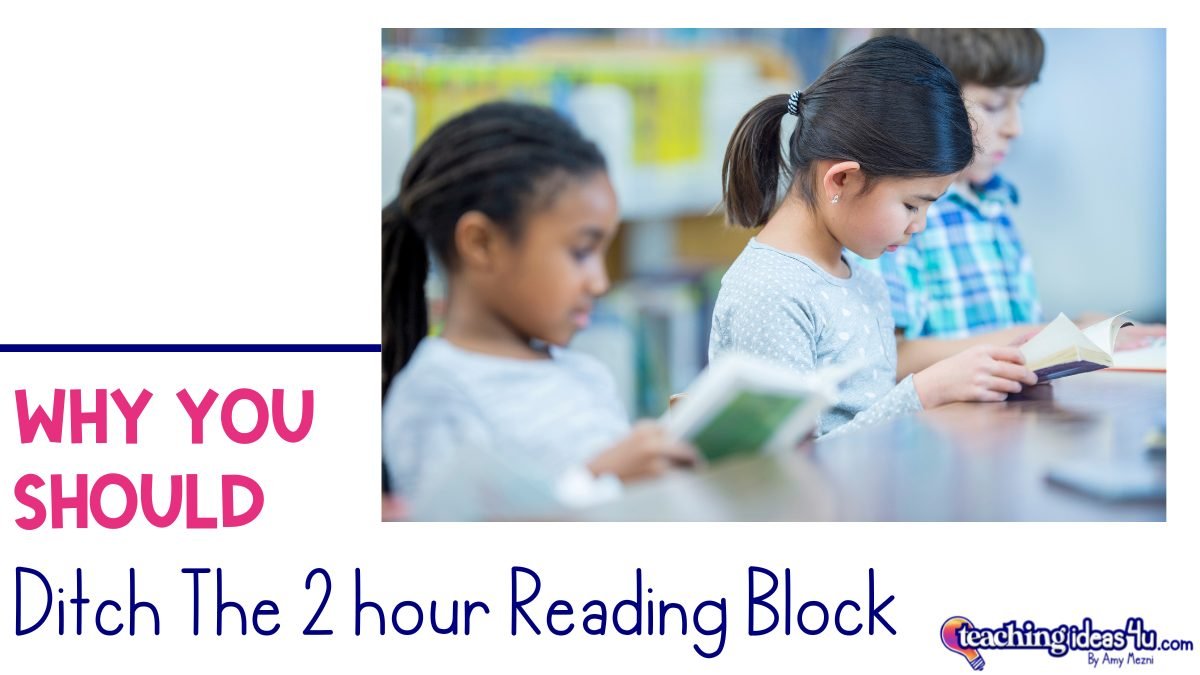Why You Should Ditch the 2-Hour Reading Block
Have you ever struggled to cover all your content with a two-hour (or longer) reading block? I definitely did.
I actually remember when my district declared elementary classes were required to have a minimum of two hours for reading. My teammates and I spent hours trying to develop a schedule that fit everything.
In the end, it was like trying to put twenty pounds into a 2-pound box. It didn’t work. Students ended up having reading and math most of the day. Science and social studies either had to be alternated or squeezed into 20-minute classes. Writing? Good luck.
We were told to integrate everything. However, it is much easier to integrate reading and writing into the other subjects than vice versa.
What has been the result of the longer reading block? According to the data, reading scores haven’t improved, and we now have a generation of people who lack a basic knowledge of geography, history, and civics.
Ditch the Reading Block
According to the Thomas B. Fordham Institute, research shows social studies instruction increases reading scores. The Institute analyzed data from a federal Early Childhood Longitudinal Study and found that students who had more minutes of social studies instruction had greater improvements in their reading ability.
The longitudinal study tracked nearly 7,000 students from across the United States who started kindergarten in 2011. It compared the number of instructional minutes in each subject students had from first to fifth grade with their fifth-grade reading scores.
Only social studies instruction showed a positive impact on reading scores. Each half-hour of social studies instruction per day increased fifth-grade reading scores an average of 0.15 of a standard deviation higher.
More minutes of reading instruction did not correlate to higher reading scores.
Certain students benefited more from an increase in social studies instruction than others, including girls and students from lower-income or non-English-speaking homes. However, students in the top 25 percent in socioeconomic status did not have gains from more social studies instruction.
Why Social Studies Helps with Reading
As teachers, one of the first things we do is design activities to activate schema, or prior knowledge. We know students remember new information better when they connect it to what they already know.
Social studies instruction helps build that background knowledge. When students can activate prior knowledge on a reading topic, their reading comprehension increases.
It’s possible that some students benefit more from social studies instruction because they have fewer opportunities to have experiences that build background knowledge, such as travel and going to performances.
Classroom Implications
Teachers need to be realistic about the conclusions of this analysis. The reading gains were small, so social studies instruction is not the end-all to improving reading comprehension. The study also does not prove that social studies instruction caused the increase - other factors could be influencing the students’ reading abilities.
So what should teachers take away from this information?
Teaching reading as discrete skills is not as effective as integrating reading instruction into rich-content. Instead of focusing a lesson on a reading skill, such as the main idea or author’s purpose, teachers should develop a lesson on a topic and teach the reading skill during that lesson.
Although the study does not definitively correlate social studies instruction to reading comprehension, this analysis suggests returning to integrated instruction might be beneficial.
Stop teaching reading as discrete skills. Instead, teach those skills through rich texts in content classes like science and social studies. Use best practices with these texts, and have students complete multiple reads of the texts to create a deeper understanding. For example, read with the teacher, then a partner, and finally individually. Use close reading strategies during these reads.
Hold conversations about the reading. In addition to discussing the content, talk about the language structure and word choice used in the text.
Return to teaching phonics and phonemic awareness. Evidence has shown that the cueing system and whole language has not been effective at teaching children to read. Use the reading instruction block to teach phonics systematically and read rich texts.
References
Barshay, Jill. “Slightly Higher Reading Scores When Students Delve into Social Studies, Study Finds.” The Hechinger Report, 6 Oct. 2020, https://hechingerreport.org/slightly-higher-reading-scores-when-students-delve-into-social-studies-study-finds/
Griffith, David, et al. “Social Studies Instruction and Reading Comprehension: Evidence from the Early Childhood Longitudinal Study.” The Thomas B. Fordham Institute, https://fordhaminstitute.org/national/resources/social-studies-instruction-and-reading-comprehension

